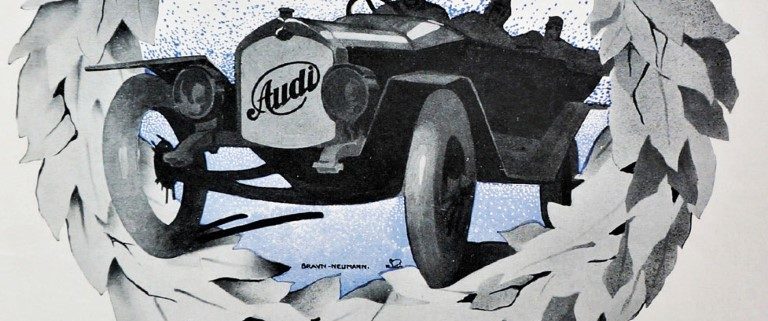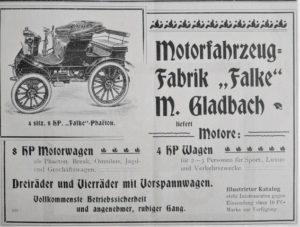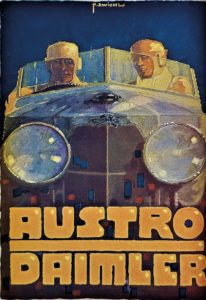Automobile advertising of the 20s and 30s
How were cars advertised in the 20s and 30s? How was society made aware of new achievements in the automotive industry and the brands behind them and persuaded to buy motor vehicles?
In the Ferdinand Porsche Worlds of Experience, a special exhibition answers these questions and provides insights into the first advertising subjects, their creators and the media used for advertising. The advertising and graphics of the 1920s and 1930s is illuminated throughout the entire exhibition area of the fahr(T)raum Mattsee classic car museum near Salzburg.
Advertising graphics also developed with the progress of the industrial age
From the „Allgemeinen Automobilzeitung“ , 1900 Band I.
In the automotive sector, the promoted subjects were initially very text-intensive. Long descriptions of the reliability of the cars were paramount; colours and brand images remained in the background and were often not uniform. In the 1920s, three graphic artists then laid the foundation for poster design: Lucian Bernhard, renowned poster artist from Berlin, who designed subjects for Bosch, among others. His motto: concision by illustrating the product and the brand name. The second was Ludwig Hohlwein, who conveyed emotions and image via the two-dimensional images on his posters; for Mercedes, for example. Finally, there was Julius Klinger from Vienna, whose likewise illustrative posters were characterised by humour. The logos and lettering of these three luminaries have often remained essentially unchanged to this day.
Automotive advertising in the First World War
Mass production of automobiles began during the First World War, and the promotional publicity for them was mainly aimed at their superiority in wartime deployment. The advertisements and posters also showed proud, uniformed officers and often simultaneously advertised the production of aircraft engines.
The Golden Age of Automobile advertising
Automobile adverstising of Austro Daimler in the 20s.
The Golden Age followed in the interwar period. The car had reached the middle of society. Advertising was now about establishing brands, not about technical advantages. Artistic movements were taken up in the subjects – from Cubism, Art Deco and Futurism to Modernism. The competition between car manufacturers and artful, dreamlike advertising reached its peak. This ended with the Great Depression of 1928/1929 and the period of National Socialism.
Advertising graphics at Autro-Daimler
At Austro-Daimler, the graphic artist “F. Zwickl” in particular made a name for himself. Little is known about him, so the fahr(T)raum team set out to find information about this creative spirit. See the results of this search for yourself in the classic car exhibition!
The special exhibition can be viewed throughout the year in the entire exhibition area of Ferdinand Porsche Worlds of Experience fahr(T)raum in Mattsee, daily from 10:00 a.m. to 5:00 p.m. With further information, graphics and advertising subjects of automobile advertising in the 20s and 30s.
Quellen
Special exhibition about automobile advertising in the classic car and automobile museum Ferdinand Porsche Erlebniswelten fahr(T)raum in Mattsee.
Image verification fahr(T)raum archiv:
image 1 Audi advertisement around 1913.
image 2 “General automobile newspaper”, 1900 volume I.
image 3 Austro Daimler advertisement around 1920.
That might also interest you:









The first traffic rules – displacement and adaptation caused by the automobile
/in Geschichte, NewsAround 1900, as was the case for millennia, the horse still dominated in the transport of people and loads. Only the utmost upper class could afford private cars. In 1914, people were already crying “Vienna is choking with traffic”, although at that time there were only about 4,000 cars in Austria´s capital. Today, in Vienna […]
Ferdinand Porsche´s time at Steyr: ingenious pit stop
/in Geschichte, Lebensstationen, NewsAfter his career as Technical Director at the Austrian Daimler Motor Co. Austro Daimler in Wiener Neustadt from 1906 to 1923, Ferdinand Porsche was responsible at Daimler-Motoren-Gesellschaft in Stuttgart as a member of the Management Board as well as design manager. After a merger with Benz & Cie to become Daimler-Benz AG in 1926, Porsche’s […]
3. Classic motorcycle special exhibition – sidecars from 1926
/in Geschichte, News, Sonderausstellung, Sonstige FahrzeugeFor the third year running, the classic motorcycle special exhibition will kick off at fahr(T)raum Mattsee from 1 October – this year under the title “Right or Left …. around the world”. A total of 15 historic motorcycle and sidecar rigs from 1925-1960 are on display including, inter alia, a Royal Enfield 1000 with sports […]